Menu
Download the accompanying materials to this lesson plan - sign up here
Resources and materials for ESL Kids teachers
This is a fun lesson which introduces some common vegetables. Students will sing a song, make a vegetable basket craft and practice saying their likes and dislikes.
See our "Warm Up & Wrap Up" page.
1. Play "Find the Vegetables"
If possible, before class buy one of each of the following vegetables (and other kinds if you like): a carrot, a potato, a cabbage, an onion, a pumpkin, corn (on the cob if possible), a radish, a lettuce. If you can’t bring vegetables into class, other options are: plastic vegetables (sometimes available at dollar shops and toy shops), vegetable flashcards, vegetable photos cut out of free supermarket magazines. Also, bring in a basket for the vegetables.
Before your students enter your classroom hide the vegetables all around the room – in draws, behind books, under things, etc. Once you are ready to begin the main part of your lesson, have everyone sit down and say to your students "Let’s look for some vegetables!".
Then stand up and demonstrate that you are searching for something. Find one of the vegetables (e.g. under a cushion) and show your thrill in doing so. Take it over to the basket and drop it in saying "Put it in the basket". Then get everyone to hunt around the room until all of the vegetables have been found and placed in the basket.
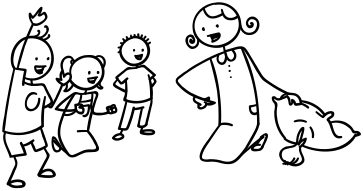
2. Teach vegetable vocabulary
Hold up the first vegetable and chorus the word three times (e.g. "carrot, carrot, carrot"). Then pass the vegetable around the class, each student saying the name as they pass it. Do this for all of the vegetables.
3. Play "The Missing Vegetable" and "Blindfold Touch"
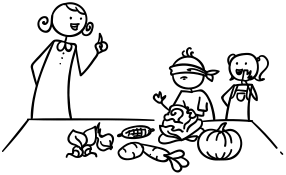 Line all the vegetables up on a desk. Say "Close your eyes" and get everyone to cover and close their eyes. Take away one of the vegetables and hide it behind your back – everyone must open their eyes and shout out the missing vegetable. Play this until all of the vegetable vocabulary has been practiced.
Line all the vegetables up on a desk. Say "Close your eyes" and get everyone to cover and close their eyes. Take away one of the vegetables and hide it behind your back – everyone must open their eyes and shout out the missing vegetable. Play this until all of the vegetable vocabulary has been practiced.
Keep the vegetables lined up on the desk. Take out a blindfold and model the activity – put on the blindfold then touch and feel one of the vegetables. Look confused and say the wrong word (e.g. touch a cabbage and say "Is it a carrot?"). Get the students to help you until you guess correctly. Then blindfold one student, turn him/her around 3 times and help him/her to go to the desk and touch/feel one vegetable and say what it is. Give all of the students a go.
4. Play "Musical Pass the Vegetables"
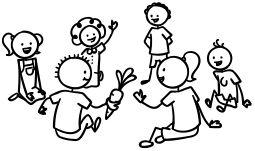 Sit everyone in a circle, put on some music, and have everyone pass all of the vegetables around the circle (in the same direction). So the music will be playing and all of your vegetables will be going around the circle. Suddenly stop the music – the students holding the vegetables must shout out the name of the vegetable they are holding. The last person to shout out the correct word is out (and also remove their vegetable). Keep playing, with each round the last person going out. This should end with just 2 students passing two vegetables back and forth. It’s a really fun game!
Sit everyone in a circle, put on some music, and have everyone pass all of the vegetables around the circle (in the same direction). So the music will be playing and all of your vegetables will be going around the circle. Suddenly stop the music – the students holding the vegetables must shout out the name of the vegetable they are holding. The last person to shout out the correct word is out (and also remove their vegetable). Keep playing, with each round the last person going out. This should end with just 2 students passing two vegetables back and forth. It’s a really fun game!
5. Read classroom reader: The Farmer's Vegetables
Before class, download and print off the reader "The Farmer's Vegetables". As you go through each page, point to the pictures and elicit each key word, and also make sure everyone is aware if the rabbit hiding in each picture, for example:
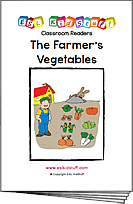 Teacher: What is this?
Teacher: What is this?
Students: Corn!
Teacher: And what's missing?
Students: Carrots!
Teacher: And who's hiding here?
Students: A rabbit!
Get the students really involved in the story by asking lots of questions (e.g. eliciting colors, clothes and other objects) and try and get everyone to speculate why the vegetables keep disappearing.
After reading the story, give out a reader worksheet to each student and read through the story one more time (without stopping for questions, etc.) as students write the order that the rabbit eats the vegetables. Then go through the answers as a class.
---
Alternatively, watch our video version of the reader (Internet connection required):
6. Sing "Mr. Farmer’s Vegetables"
Prepare for the song by taking out the flashcards of the vegetables. Show each one in the order of the song (so carrot first, potato next, etc.) and stick each one on the walls of the classroom. Try and get it so that the cards are evenly distributed around the walls (still in the order of the song) so you will have to turn 360 degrees to look at all of the cards. Alternatively, you can use the song poster.
Get everyone to stand up and dance, sing and point to the vegetables (as described in Gestures for "Mr. Farmer’s Vegetables" below). You can play the song 2 or three times.
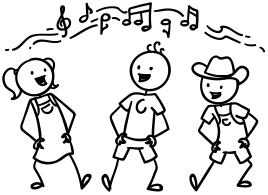 Lyrics for "Mr. Farmer’s Vegetables"
Lyrics for "Mr. Farmer’s Vegetables"
Chorus:
Oh, Mr. farmer, what are you growing?
On your farm, on your farm.
Oh, Mr. farmer, tell us what you’re growing,
On your farm, on your farm.
Verse 1:
I am growing carrots, carrots,
I am growing potatoes, potatoes,
I am growing cabbages, cabbages,
I am growing onions, onions.
Chorus:
Oh, Mr. farmer, what are you growing?
On your farm, on your farm.
Oh, Mr. farmer, tell us what you’re growing,
On your farm, on your farm.
Verse 2:
I am growing pumpkins, pumpkins,
I am growing corn, corn,
I am growing radish, radish,
I am growing lettuce, lettuce.
Before playing the song, put flashcards of the vegetables all around the walls of the classroom (in the same order of the song). Then start the song and do the following gestures:
We also have a video that you can stream in class to sing along with (Internet connection required):
7. Do the "Vegetable Basket Craft".
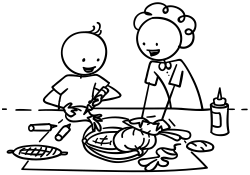 Use the following craft sheets:
Use the following craft sheets:
Before class, print off enough craft sheets for each student as well as yourself and cut out the basket and vegetable pictures. Give the cut-outs to each student and then get everyone to follow you as you color in the vegetables and the basket – as you are doing this chat with your students, asking questions such as "What color shall we use for the potato?", "Do you like cabbage?", "What’s your favorite vegetable?", etc.
When everything has been colored in, glue the baskets to construction paper and get the students to put in their vegetables (have them say the names of the vegetables as they do so).
An alternative is to print off just one large basket and get everyone to put their colored vegetables into the "class basket".
8. Play "Let’s make Vegetable Soup"
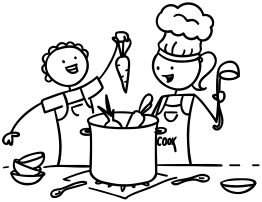 To finish off the lesson we are going make some imaginary vegetable soup. You need a large cooking pot, ladle and some plastic/paper bowls and spoons.
To finish off the lesson we are going make some imaginary vegetable soup. You need a large cooking pot, ladle and some plastic/paper bowls and spoons.
Say "I’m hungry. Let’s make some soup!" (while rubbing your empty stomach). Take out the large pot and say "Let’s cook vegetable soup! We need some vegetables". Model by taking one of your vegetable cut-outs from your craft basket – say "Yummy, I like (radish)" and put it into the pot and stir. Then say, "Hmm. We need some more vegetables". Invite each student to take some of their vegetables from their craft basket and put into the pot, saying "Yummy, I like ~". Keep stirring – you can also invite students to give the soup a stir.
Finally, say "The soup is ready!". Get everyone to hold out their bowls and ladle in some imaginary soup. If some students refuse, this is fine – try and get them to say "I don’t like vegetable soup". Then say "Let’s eat!". Make lots of slurping noises and say things like "Yummy!" and "Delicious!" and encourage everyone else to do the same. You can even offer seconds! Finish off by getting everyone to retrieve their vegetable cut-outs from the pot and put back into their baskets.
1. Assign Homework: "Vegetable Basket" worksheet.
2. Wrap up the lesson with some ideas from our "Warm Up & Wrap Up" page.
 Found a mistake?
Found a mistake?
Please let us know
Full access to all resources on ESL KidStuff including lesson plans, flashcards, worksheets, craft sheets,
song downloads, classroom readers, flashcards app and songs app.